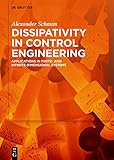Dissipativity in Control Engineering : Applications in Finite- and Infinite-Dimensional Systems / Alexander Schaum.
By: Schaum, Alexander [author.] .
.
Material type:  BookPublisher: Berlin ; Boston : De Gruyter, [2021]Copyright date: ©2021Description: 1 online resource (XIV, 228 p.).Content type: text Media type: computer Carrier type: online resourceISBN: 9783110677942.Subject(s): Regelungstechnik
BookPublisher: Berlin ; Boston : De Gruyter, [2021]Copyright date: ©2021Description: 1 online resource (XIV, 228 p.).Content type: text Media type: computer Carrier type: online resourceISBN: 9783110677942.Subject(s): RegelungstechnikFrontmatter -- Preface -- Contents -- About the author -- List of Figures -- Part I: Introduction and motivation -- 1 Motivation and problem formulation -- Part II: Theoretical foundations -- 2 Stability, dissipativity and some system-theoretic concepts -- 3 Dissipativity-based observer and feedback control design -- Part III: Application examples -- Introduction -- 4 Finite-dimensional systems -- 5 Infinite-dimensional systems -- 6 Conclusions and outlook -- A Lemmata on quadratic forms -- B Kalman decomposition for observer design -- C The algebraic Riccati equation, optimality and dissipativity -- D Kernel derivations for the backstepping approach -- Bibliography -- Index
restricted access online access with authorization star
http://purl.org/coar/access_right/c_16ec
Dissipativity, as a natural mechanism of energy interchange is common to many physical systems that form the basis of modern automated control applications. Over the last decades it has turned out as a useful concept that can be generalized and applied in an abstracted form to very different system setups, including ordinary and partial differential equation models. In this monograph, the basic notions of stability, dissipativity and systems theory are connected in order to establish a common basis for designing system monitoring and control schemes. The approach is illustrated with a set of application examples covering finite and infinite-dimensional models, including a ship steering model, the inverted pendulum, chemical and biological reactors, relaxation oscillators, unstable heat equations and first-order hyperbolic integro-differential equations.
Issued also in print.
Mode of access: Internet via World Wide Web.
In English.
Description based on online resource; title from PDF title page (publisher's Web site, viewed 01. Dez 2022)


There are no comments for this item.